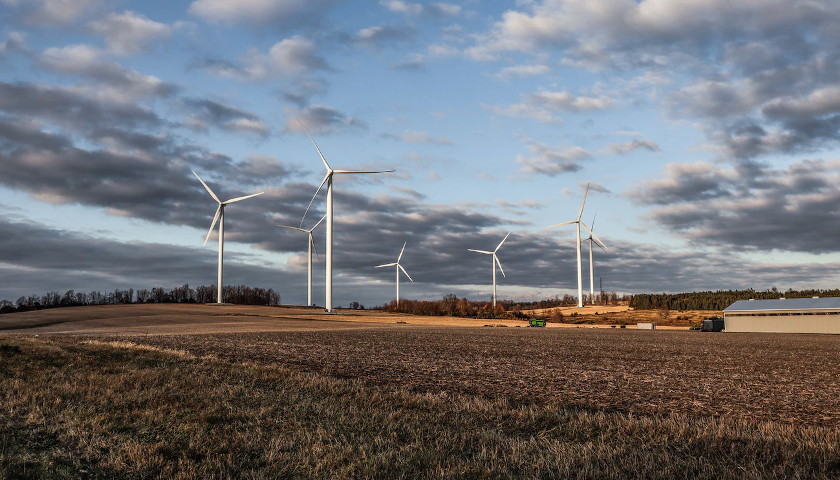In January, the top of a massive wind turbine crashed down on a field in rural Dodge County, not far from the town of Herman.
The impact scattered pieces of blades and large chunks of debris. Nobody was hurt—this time.
A bill being shopped for sponsorship aims to protect the public from the potential dangers of these renewable energy giants — and from big government.
“Local elected officials have an obligation to look out for the wellbeing of all their residents, and many are concerned that proposed industrial wind turbine projects may potentially not be a good fit in some areas given the density of rural homes and experienced negative health effects,” the bill’s authors, State Rep. Ty Bodden (R-Stockbridge) and State Sen. Andre Jacque (R-De Pere), wrote in a co-sponsorship memo this week.
The proposal, according to the lawmakers, would restore the ability of towns and counties to impose a restriction on a wind energy system that is more restrictive than Wisconsin Public Service Commission rules.
There are limitations, however. A restriction could only be adopted if it preserves or protects public health or safety. It could not significantly increase the cost of the system or significantly decrease the system’s efficiency. And any restriction would have to allow for an alternative system of comparable cost and efficiency, the bill draft states.
Currently, under the law, no political subdivision can enact ordinances stricter than PSC-128 (the current wind turbine siting rules), even in the interests of public health and safety, the bill sponsorship memo states.
“When PSC-128 was created in 2010, scientific information about illnesses caused by new 500 foot tall and larger wind turbines located too close to peoples’ homes wasn’t as well known,” the lawmakers wrote. “Since then, dozens of new peer reviewed studies show that there are harmful noise and other emissions from wind turbines that the PSC rules were not designed to protect against.”
Wind Turbine Syndrome
Industrial wind projects have spread across much of the country, in a nation that ranks second in wind power. Some residents living around the massive turbines have reported an array of symptoms, from fatigue and sleep disorders to panic episodes and tachycardia — a heart rate over 100 beats per minute.
The symptoms fall under a general disorder commonly referred to as “Wind Turbine Syndrome,” believed to be caused by low frequency sounds emanating from the massive mills. Most scientists have dismissed Wind Turbine Syndrome as bunk, pointing to a raft of peer-reviewed evidence finding no ill effects. Some insist the syndrome is nothing more than a psychosomatic condition born out of fear, generated in the minds of people predisposed to oppose the view-cluttering renewable energy farms.
But the rising number of illness-related complaints from people living near wind farms is hard to dismiss. And the science community that turned out to be so wrong about aspects of the pandemic and the vaccinations produced to fight it hasn’t helped ease concerns.
In Glenmore, WI, turbines were declared “Human Health Hazards” by the Brown County Board of Health and numerous affidavits have been submitted to the county and state attesting to harm being done to those that live there.Health Director Chua Xiong, however, ruled in December 2015 that insufficient scientific evidence existed to definitively determine the wind farm caused health issues.
Like the Statue of Liberty Falling Down
There’s no doubt giant turbine failures are on the uptick, according to recent report in Popular Mechanics.
“Multiple turbines that are taller than 750 feet are collapsing across the world, with the tallest—784 feet in stature—falling in Germany in September 2021,” the magazine reported. “To put it in perspective, those turbines are taller than both the Space Needle in Seattle and the Washington Monument in Washington, D.C. Even smaller turbines that recently took a tumble in Oklahoma, Wisconsin, Wales, and Colorado were about the height of the Statue of Liberty.”
As Bloomberg reported, all three of the major manufacturers have admitted the zeal to make bigger turbines has led to manufacturing issues.
Pushing a far left climate change agenda, the Biden administration has made the proliferation of wind farms a priority. Biden’s $739 billion, ill-named Inflation Reduction Act includes nearly $370 billion to fund his pet energy and climate projects.
“Wind Turbines: The Bigger the Better,” declared the Department of Energy’s Office of Energy Efficiency and Renewable Energy declared in a 2022 report celebrating the growth of turbines.
“We’re seeing these failures happening in a shorter time frame on the new turbines,” Fraser McLachlan, CEO of insurer GCube Underwriting, told Bloomberg, “and that’s quite concerning.”
Meanwhile, the renewable energy industry is decrying local governments taking back control over wind farm siting. The Sabin Center for Climate Change Law at Columbia Law School found that “in nearly every state, local governments have enacted policies to block or restrict renewable energy facilities and local opposition has resulted in the delay or cancellation of particular projects.”
The Wisconsin bill would not affect existing wind energy systems already permitted and would not change the PSC wind siting process for the statewide standards, the lawmakers wrote in the bill sponsorship memo. It only removes the prohibition of towns or counties to enact ordinances that serve to protect public health or safety.
– – –
M.D. Kittle is the National Political Editor for The Star News Network.





